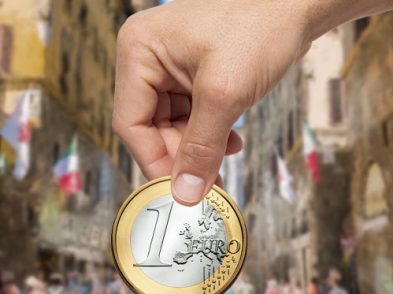Notwithstanding the global economic crisis, for many investing in property, or ?bricks and mortar’ as we say in Italian, has been until now one of the most attractive forms of investment, especially in Italy. In our countryside, as well in the historical centers of our beautiful region, it is still possible to find good deals to convert old farmhouses into international businesses, like agritourisms or holiday houses. At least it was until more recently. Among the initiatives of the Monti government to generate additional revenue is one of the most disliked taxes in Italy: property tax. Called IMU (?Imposta municipale unica’), this levy affects anyone who resides in and owns a real estate property (such as an apartment, villa, commercial space, garage, agricultural lands, and so forth) in Italy. With a few exceptions, such as public and religious buildings, any kind of property is subject to this newly reintroduced levy on property, which replaces the former ICI property tax that the Berlusconi government eliminated. The tax is calculated based on a percentage of the value of each property, and it will be collected by the municipality in which the property is located, with part of the tax also going to the national government.
HOW TO CALCULATE THE IMU TAXEach property has a cadastral rental value (rendita catastale) that is reported in the public deed of the purchase of the property. You will need to know this value in order to determine the amount of IMU you have to pay. If you no longer have a copy of the purchase deed, you can ask for the rendita catastale of your property at your local Agenzia del Territorio (Local Land Registry). For properties located in the municipality of Florence, the office is at via dell’Agnolo 80.
Once you know the cadastral value of your property, you must increase it by 5 percent, then multiply that number by a coefficient that depends on the type of property. For apartments and other residential buildings, the coefficient is 160. For a shop or similar commercial premises, it is 55. The result will be the tax base of your venue.
Finally, on that tax base you will apply a rate that ranges from 0.4 percent to 0.76 percent for your main residence (the one where owners habitually reside), but in some cases, as we will see, the rate can reach 1.06 percent.
If your main residence is in Florence, you will apply a 0.4 percent rate (the lowest possible rate in Italy, as rates may vary in municpalities across the country).
There is also a 200-euro deduction on the IMU tax for main residences, plus an extra deduction of 50 euro per child under 26 years residing in the same home.
Once calculated, this will be the amount of IMU you have to pay.
AN EXAMPLE IN FLORENCEImagine that you own an apartment in the center of Florence. It is your principal residence and it has a cadastral rental value of 1,000 euro and you have no children under 26 living with you (remember: the deduction on children is possible only on principal homes).
The procedure to calculate the IMU would be the following (Source: blog.panorama.it):
1,000 x 1.05 percent (revaluation) x 160 (coefficient) = 168,000.00 euro (tax base)
Because the apartment is in Florence and it is your principal residence, you have to multiply that tax base (168,000) by the 0.4 percent rate.
672 euro – 200 euro (deduction) = Total IMU owed: 472.00 euro
Perhaps you also own a second residence. In Florence, second houses (such as holiday homes or rented apartments) are taxed using two different rates:
A 0.76 percent rate is applied if the apartment is rented using the suitable form of rental agreement (law 431/98). The IMU would be 1,276.80 euro annually.
However, if the apartment is rented with other forms of agreements, the tax rate rises to 0.99 percent. In this case, the IMU would be 1,663.20 euro per year.
The rate rises to 1.06 percent if the apartment or property is not rented. The IMU for an unrented second home in Florence could reach 1,780.00 euro per year.
The City of Florence hopes the reduced rate (0.76 vs 1.06 percent, which could mean more than 500 euro less in taxes to be paid as per the examples given) will encourage owners to rent apartments they have kept empty and make legal any rental agreements that are not legally registered-a common practice in Italy to evade taxes.
WHAT’S GOOD ABOUT IMUIndeed, one of the few ?positive’ effects of this levy could be the drop in rental prices, which have already decreased (even before IMU came into effect) 5 percent in the last six months. By taxing vacant apartments at a higher rate, the government has made it is more convenient for many owners to sell or rent out second homes outside of their municipality in an effort to pay less tax. Many investors believe that the direct consequence of a higher number of apartments on the rental market will be lower rent prices.
WHEN TO PAY ITThe IMU for principal homes can be paid two ways: 1) in three installments of 33.33 percent each any time before the deadlines of June 18, September 17, and December 17; or 2) in two installments of 50 percent each by June 18 and by December 17. For the other types of property, payments can be made only in two installments (June and December). So, for everyone, the first deadline is June 18, 2012.
TAXES ON PROPERTIES OWNED ABROADIf you are a taxpayer in Italy, regardless of your nationality, you are supposed to declare on your Italian income tax report all of the properties you own abroad. There are some conditions in which real estate owned abroad can be taxed; it depends on how much that property is already taxed in the foreign country. These properties can be subject to a national levy called IVIE (?Imposta sul valore degli immobili degli immobili all’estero’), which is a levy on the value of real estate owned in foreign countries.
The levy for this type of property is calculated by multiplying the purchased value (or the market value) of that property by 0.76 percent. The characteristics of this levy on foreign properties are still not clear, and we need to wait for clarification from Italy’s tax authorities, but it seems probable that if the house is already taxed in the country where it is located, it will not be taxed again in Italy.
As I understand it, the aim of the IVIE levy is to hit the second homes that some wealthy Italians have purchased in places like Morocco or Miami. However, expatriates who have decide to move (and even invest) in Italy may also suffer the consequences of this levy. I find very questionable the principle of making money by taxing the property that a foreign citizen has in his or her country, just because he or she resides in Italy. Isn’t it an unfair meddling in another countries’ business? Let’s just hope that this new law will not definitively scare away tourists and investors in Italy.
CONCLUSIONSMy personal (not professional) opinion is that investing in Italy is still a good business, especially if your goal is to have a beautiful property and make profit from it when you are not in Italy, by taking advantage of the tourism market. However, nowadays (and this is my professional suggestion) investors need to consider not only the costs of the investment, but also the costs of maintaining the property. As I have said in previous articles, in Italy there are countless different types of taxes, levied on the local, regional and national levels. While in many Anglo-countries residents may compile their own income tax reports independently from home, in Italy, tax laws change year after year. Thus, I believe it is always best to consult an expert who can advise you on how to best report your taxes, invest your money and manage your assets. This way, you are sure to save yourself from not only from paying additional taxes and fines, but also from lots of sleepless nights. Please note that as this article went to press, there is news that changes may be made to the proposed legislation introducing the IMU. Once again, we highly recommend you seek professional advice to find out the correct amount of IMU you must pay.
DISCLAIMER: This article is intended for informational purposes only. It is not intended to give you legal advice, and should not be considered as such. None of these materials is offered, nor should be construed, as legal advice. The communication of this information or use of such information is not intended to create an attorney- client relationship. We always recommend that you specifically seek professional legal advice. The description anywhere on this page of the results of any specific case does not mean or suggest that similar results can or could be obtained in any other matter. Each legal matter should be considered to be unique and subject to varying results. Also, the information hereinafter provided is based on the current regulations enforced in Italy and therefore is subject to continuous changes and updates.
Please note that as this article went to press, there is news that changes may be made to the proposed legislation introducing the IMU. Once again, we highly recommend you seek professional advice to find out the correct amount of IMU you must pay.







